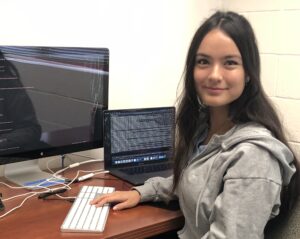
Samantha is from the Big Island of Hawai’i and currently attends Kapiolani Community College. She plans on continuing her education at University of Hawai’i at Manoa to complete her BS in Computer Science. Samantha works as a peer mentor at the KCC STEM Center where she helps students in math. She enjoys the challenges and creative aspects of programming and wants to use what she learns to come up with innovative solutions to give back to her community. In her free time, she enjoys playing sudoku and spending time with her cats.
Home Island: Big Island of Hawai’i
High School:
Institution when accepted: Kapiolani Community College
Building the Front-End and Creating a Logging System for the Next-Generation Gemini Engineering Archive
Project Site: Gemini Observatory, Hilo, HI
Mentors: Emma Kurz & Hawi Stecher
Project Abstract:
The Gemini Observatory consists of two twin telescopes: one located in La Serena, Chile, and one located on Maunakea, Hawai‘i. A vital component within this observatory is the Gemini Engineering Archive (GEA), which serves as a repository for important telescope process data. The current GEA exhibits limited user-friendliness and lacks a mechanism for accessing and visualizing log data related to the different subsystems and instruments’ operations. The aim of this project is to develop the Next Generation GEA, focusing on enhancing the front-end’s visual interface and adding a feature to visualize log data. To achieve this goal, we utilize the visualization and analytics platform Grafana to create an enhanced front-end with easy-to-understand charts, graphs, and dashboards. Additionally, the Next Generation GEA will use the software tools Elasticsearch, Kibana, and Logstash (ELK stack) to build a logging system. Within this ELK stack, we developed code for the individual instruments and subsystems of the telescope, constructing pipelines to transfer log data to the database. To construct the new interface for GEA, we wrote a Python script to request telemetry data from the current GEA’s server and transmit it to Grafana for visualization within a user-friendly interface. To deploy all of these operations, Docker containers were utilized to ensure the controlled execution environment of these systems. By implementing this Next Generation GEA, an improved understanding of the telescope’s operations will be achieved, enabling scientists to easily gather data and better understand essential telescope processes.